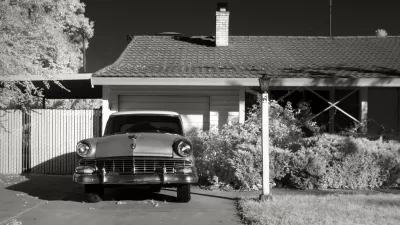The nation has a huge quantity of postwar housing that can be made more walkable and appealing to new generations of residents. Robert Steuteville examines what makes them good candidates and notes some examples of successful retrofits.

"World War II has long been considered the watershed for automobile-oriented development. Suburbs were built prior to the war, but largely were mixed-use, walkable towns and neighborhoods of the 'streetcar suburb' variety."
"After 1945, development shifted radically — to automobile-oriented housing with various types of single-use commercial development along arterial highways."
"Yet this binary view — traditional neighborhoods before the war; suburban sprawl afterward — obscures differences in postwar suburban patterns that can exert a critical impact on revitalization. Planners and theorists have in recent years been debating how to fix the suburbs, as discussed in books such as Retrofitting Suburbia by Ellen Dunham-Jones and June Williamson, and Sprawl Repair Manual by Galina Tachieva. This year, Arthur C. Nelson in Reshaping Metropolitan America made the demographic case that redevelopment of low-density commercial buildings – largely in the suburbs — could meet all of the US new housing needs in the coming decades."
"As successful case studies pile up, demonstrating the high returns generated by redevelopment associated with Leave it to Beaver neighborhoods," concludes Steuteville, "more public funds could be allocated into remaking the 'corridors of crap' into main streets. This, in turn, could generate momentum for bringing new life to the suburbs built after World War II and make US metropolitan regions more sustainable, appealing, and economically viable."
FULL STORY: Postwar neighborhoods are key to suburban revitalization

Manufactured Crisis: Losing the Nation’s Largest Source of Unsubsidized Affordable Housing
Manufactured housing communities have long been an affordable housing option for millions of people living in the U.S., but that affordability is disappearing rapidly. How did we get here?

Americans May Be Stuck — But Why?
Americans are moving a lot less than they once did, and that is a problem. While Yoni Applebaum, in his highly-publicized article Stuck, gets the reasons badly wrong, it's still important to ask: why are we moving so much less than before?

Research Shows More Roads = More Driving
A national study shows, once again, that increasing road supply induces additional vehicle travel, particularly over the long run.

Judge Halts Enforcement of Anti-Homeless Laws in Grants Pass
The Oregon city will be barred from enforcing two ordinances that prosecute unhoused residents until it increases capacity and accessibility at designated camping sites.

Advancing Sustainability in Los Angeles County Schools
The Los Angeles County Office of Education’s Green Schools Symposium brings together educators, students, and experts to advance sustainability in schools through innovative design, climate resilience strategies, and collaborative learning.

Using Old Oil and Gas Wells for Green Energy Storage
Penn State researchers have found that repurposing abandoned oil and gas wells for geothermal-assisted compressed-air energy storage can boost efficiency, reduce environmental risks, and support clean energy and job transitions.
Urban Design for Planners 1: Software Tools
This six-course series explores essential urban design concepts using open source software and equips planners with the tools they need to participate fully in the urban design process.
Planning for Universal Design
Learn the tools for implementing Universal Design in planning regulations.
City of Moreno Valley
Institute for Housing and Urban Development Studies (IHS)
City of Grandview
Harvard GSD Executive Education
NYU Wagner Graduate School of Public Service
City of Cambridge, Maryland
Newport County Development Council: Connect Greater Newport


























